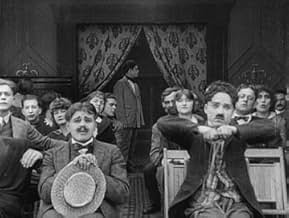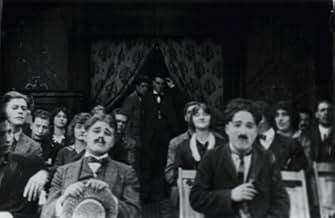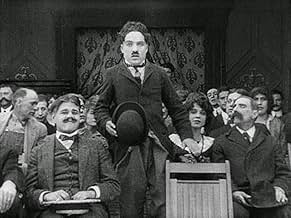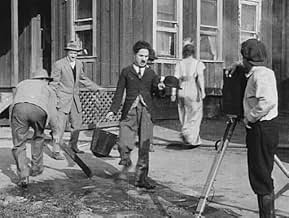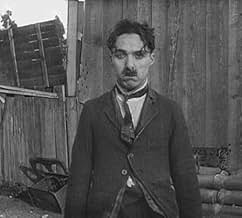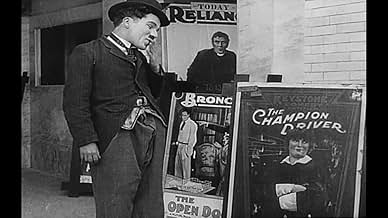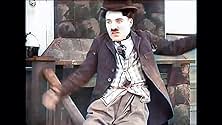PUNTUACIÓN EN IMDb
5,6/10
1,8 mil
TU PUNTUACIÓN
Añade un argumento en tu idiomaCharlie attempts to meet his favorite movie actress at the Keystone Studio, but does not win friends there.Charlie attempts to meet his favorite movie actress at the Keystone Studio, but does not win friends there.Charlie attempts to meet his favorite movie actress at the Keystone Studio, but does not win friends there.
- Dirección
- Guión
- Reparto principal
Dan Albert
- Audience Member
- (sin acreditar)
Hampton Del Ruth
- Lead Actor
- (sin acreditar)
Minta Durfee
- Self
- (sin acreditar)
- …
Billy Gilbert
- Theatre Usher
- (sin acreditar)
William Hauber
- Audience Member
- (sin acreditar)
Bert Hunn
- Audience Member
- (sin acreditar)
George Jeske
- Prop Boy in White Shirt
- (sin acreditar)
Edgar Kennedy
- Director
- (sin acreditar)
Sadie Lampe
- Audience Member
- (sin acreditar)
Henry Lehrman
- Self
- (sin acreditar)
Hank Mann
- Prop Boy in Overalls
- (sin acreditar)
Harry McCoy
- Fireman
- (sin acreditar)
- …
George Nichols
- Older Actor on Screen
- (sin acreditar)
Reseñas destacadas
Am a big fan of Charlie Chaplin, have been for over a decade now. Many films and shorts of his are very good to masterpiece, and like many others consider him a comedy genius and one of film's most important and influential directors.
He did do better than 'A Film Johnnie', still made very early on in his career where he was still finding his feet and not fully formed what he became famous for. Can understand why the Keystone period suffered from not being as best remembered or highly remembered than his later efforts, but they are mainly decent and important in their own right. 'A Film Johnnie' is a long way from a career high, but has a lot of nice things about it.
'A Film Johnnie' is not as hilarious, charming or touching as his later work and some other shorts in the same period. The story is flimsy and the production values not as audacious. Occasionally, things feel a little scrappy and confused.
For someone who was still relatively new to the film industry and had literally just moved on from their stage background, 'A Film Johnnie' is not bad at all.
While not audacious, the film hardly looks ugly, is more than competently directed and is appealingly played. Chaplin looks comfortable for so early on and shows his stage expertise while opening it up that it doesn't become stagy or repetitive shtick. The Tramp did become more likeable later but again he was still evolving.
Although the humour, charm and emotion was done even better and became more refined later, 'A Film Johnnie' is humorous, sweet and easy to like, though the emotion is not quite there. It moves quickly and doesn't feel too long or short.
Overall, far from one of Chaplin's best but pretty good and perhaps one of his better efforts from the early Keystone period. 7/10 Bethany Cox
He did do better than 'A Film Johnnie', still made very early on in his career where he was still finding his feet and not fully formed what he became famous for. Can understand why the Keystone period suffered from not being as best remembered or highly remembered than his later efforts, but they are mainly decent and important in their own right. 'A Film Johnnie' is a long way from a career high, but has a lot of nice things about it.
'A Film Johnnie' is not as hilarious, charming or touching as his later work and some other shorts in the same period. The story is flimsy and the production values not as audacious. Occasionally, things feel a little scrappy and confused.
For someone who was still relatively new to the film industry and had literally just moved on from their stage background, 'A Film Johnnie' is not bad at all.
While not audacious, the film hardly looks ugly, is more than competently directed and is appealingly played. Chaplin looks comfortable for so early on and shows his stage expertise while opening it up that it doesn't become stagy or repetitive shtick. The Tramp did become more likeable later but again he was still evolving.
Although the humour, charm and emotion was done even better and became more refined later, 'A Film Johnnie' is humorous, sweet and easy to like, though the emotion is not quite there. It moves quickly and doesn't feel too long or short.
Overall, far from one of Chaplin's best but pretty good and perhaps one of his better efforts from the early Keystone period. 7/10 Bethany Cox
Edgar English's work in this picture will keep it amusing. There are many good situations, fresh and laughable, and the offering ought to be welcome everywhere as a Tightener of the program. Camera work helps a lot. - The Moving Picture World, March 7, 1914
According to some of the central figures involved, including Charlie Chaplin and producer Mack Sennett, Chaplin's first weeks making movies at the Keystone Studio were not pleasant ones. No one knew what to make of this temperamental young Englishman, while Chaplin, for his part, was bewildered by film technique and didn't get along with his colleagues. Though it may seem hard to believe now, there were serious doubts all around that Chaplin could make good in the movies.
Viewed in this light Chaplin's fifth comedy, A Film Johnnie, a fairly amusing short in its own right, takes on some additional historical weight as something of an inside joke, an indirect comment on Chaplin's actual off-screen status at his studio. In the opening sequence a scruffy-looking Charlie goes into a cinema and sees a Keystone comedy featuring an actress he admires. When her co-star, an older man, gets fresh with her Charlie becomes so upset and agitated he is ejected from the theater. He heads straight to the Keystone Studio, seeking to get in. (Thus the title: he's like the "stage door johnnies" who would hang around theaters, hoping to meet the performers and/or get a job with the acting company.) He watches as prominent performers such as Roscoe Arbuckle and Ford Sterling, wearing their street garb, step out of cars and casually enter the studio, smiling and chatting. They're members of the In Crowd, but he is not. Approaching a bemused Arbuckle, he requests and receives a hand-out. He tries this again with Sterling, but -- in a reflection of their alleged off-camera friction? -- receives nothing; Sterling even takes the coin Arbuckle had given Charlie earlier. The studio director (Edgar Kennedy) refuses Charlie admission, but he easily slips past the elderly doorman. Once inside he finds the girl he so admires (Virginia Kirtley) but ruins the scene she's acting in because he believes it's actually happening. He runs amok with a prop pistol, scaring everyone, then leaves.
The comic mayhem that occurs in the studio and at a nearby house fire --which might have been a real event-- amounts to routine Keystone knockabout, apparently improvised while the cameras were rolling. Charlie contributes some cute gags: he lights a cigarette by shooting it with a pistol, and starts to kick a stage hand but when the man turns he quickly switches to scratching his ankle. What's really of interest here is the context and the subtext: essentially Chaplin was still on probation when this film was made, and his colleagues' wariness towards him appears to be genuine. A Film Johnnie captures a time when Charlie hadn't made the grade, just yet.
Viewed in this light Chaplin's fifth comedy, A Film Johnnie, a fairly amusing short in its own right, takes on some additional historical weight as something of an inside joke, an indirect comment on Chaplin's actual off-screen status at his studio. In the opening sequence a scruffy-looking Charlie goes into a cinema and sees a Keystone comedy featuring an actress he admires. When her co-star, an older man, gets fresh with her Charlie becomes so upset and agitated he is ejected from the theater. He heads straight to the Keystone Studio, seeking to get in. (Thus the title: he's like the "stage door johnnies" who would hang around theaters, hoping to meet the performers and/or get a job with the acting company.) He watches as prominent performers such as Roscoe Arbuckle and Ford Sterling, wearing their street garb, step out of cars and casually enter the studio, smiling and chatting. They're members of the In Crowd, but he is not. Approaching a bemused Arbuckle, he requests and receives a hand-out. He tries this again with Sterling, but -- in a reflection of their alleged off-camera friction? -- receives nothing; Sterling even takes the coin Arbuckle had given Charlie earlier. The studio director (Edgar Kennedy) refuses Charlie admission, but he easily slips past the elderly doorman. Once inside he finds the girl he so admires (Virginia Kirtley) but ruins the scene she's acting in because he believes it's actually happening. He runs amok with a prop pistol, scaring everyone, then leaves.
The comic mayhem that occurs in the studio and at a nearby house fire --which might have been a real event-- amounts to routine Keystone knockabout, apparently improvised while the cameras were rolling. Charlie contributes some cute gags: he lights a cigarette by shooting it with a pistol, and starts to kick a stage hand but when the man turns he quickly switches to scratching his ankle. What's really of interest here is the context and the subtext: essentially Chaplin was still on probation when this film was made, and his colleagues' wariness towards him appears to be genuine. A Film Johnnie captures a time when Charlie hadn't made the grade, just yet.
The film was produced in March 1914, during the post-Mabel's Strange Predicament period when Mabel Normand was still refusing to work with Chaplin (Mack Sennett's autobiography). Sennett, however, managed to get Mabel into the film by displaying a poster depicting her as a champion racing driver. Chaplin is meant to fall in love with her image, but note that he takes the opportunity to disrespect the Keystone Girl by mocking her dirty, oily face. This is probably the film where new-boy Chaplin later says he had an angry confrontation with director 'Pops' Nichols. Long-serving Popsie almost had a seizure when the ranting Charlie told the old guy he knew nothing about directing pictures!
In any event, the warring pair managed to finish the movie, which has a weak story-line, but gives Sennett an advertising opportunity for Keystone. Charlie goes on to create uproar in the picture house when he sits on Mrs Arbuckle's lap, and overdoes the emotional stakes when Keystone's Peggy Pearce appears on screen.
Having been thrown out of the picture-house, Charlie decides to get down to the Keystone studios and meet the stars. He appears at Keystone as car loads of the company arrive, including Fatty Arbuckle from who he begs a dime. Minta Arbuckle merely laughs at the tramp- like Charlie, who she later described as being dirty and smelly. Incidentally the studio is not the real lot, and the set appears to be among some very upper-crust accommodation indeed. It is in fact the swanky Bryson Apartments on Wilshire Boulevard! After being told 'No bums here' by director Edgar Kennedy, Charlie forces his way into the studio, and who should he see on the set but the Keystone girl to die for – Peggy Pearce. Following attempts to force himself on Peggy and interfere with the action, Charlie acquires a revolver and begins to shoot up the set, sending the cast diving for cover. Our tramp now leaves the studio, slams the door behind him, and gives the aging doorman a swift kick.
A house fire occurring in the vicinity, sends the cast racing off in the Keystone cars, in order to obtain some 'atmosphere' for their film. For some unexplained reason, crazy Charlie is already on his way to the scene, and running down the middle of Wilshire Boulevard (or is it Broadway?). When Charlie reaches the fire (which appears to be in dusty old Edendale) he finds the film crew already setting up for a scene in which Peggy Pearce is being roughed up. The gallant tramp intervenes and incurs the wrath of the studio men, one of whom tries to brain him with a plank. When Charlie attempts to abduct Peggy, she responds by giving the tramp a good whipping.
According to Sennett, Chaplin had no designs on any of the Keystone starlets, and no success with women in general during 1914. He was right about the second part, but Charlie made amorous advances to both Peggy Pearce and Mabel Normand. Both were eventually to reject the 'lovable genius of a problem child' (as Mary Pickford called Chaplin). Several of Chaplin's sworn enemies are in this picture, including Pathe Lehrman and Pops Nichols. Everyone made representations to Sennett that Chaplin was impossible to work with, but Lehrman also said that Chaplin was in love with Mabel, and that Mabel was having various affairs (including, somewhat later, with Valentino). How did Sennett respond? He took the Tramp and the Jazz Babe out to dinner every night – what better way of keeping an eye on the recalcitrant pair.
In any event, the warring pair managed to finish the movie, which has a weak story-line, but gives Sennett an advertising opportunity for Keystone. Charlie goes on to create uproar in the picture house when he sits on Mrs Arbuckle's lap, and overdoes the emotional stakes when Keystone's Peggy Pearce appears on screen.
Having been thrown out of the picture-house, Charlie decides to get down to the Keystone studios and meet the stars. He appears at Keystone as car loads of the company arrive, including Fatty Arbuckle from who he begs a dime. Minta Arbuckle merely laughs at the tramp- like Charlie, who she later described as being dirty and smelly. Incidentally the studio is not the real lot, and the set appears to be among some very upper-crust accommodation indeed. It is in fact the swanky Bryson Apartments on Wilshire Boulevard! After being told 'No bums here' by director Edgar Kennedy, Charlie forces his way into the studio, and who should he see on the set but the Keystone girl to die for – Peggy Pearce. Following attempts to force himself on Peggy and interfere with the action, Charlie acquires a revolver and begins to shoot up the set, sending the cast diving for cover. Our tramp now leaves the studio, slams the door behind him, and gives the aging doorman a swift kick.
A house fire occurring in the vicinity, sends the cast racing off in the Keystone cars, in order to obtain some 'atmosphere' for their film. For some unexplained reason, crazy Charlie is already on his way to the scene, and running down the middle of Wilshire Boulevard (or is it Broadway?). When Charlie reaches the fire (which appears to be in dusty old Edendale) he finds the film crew already setting up for a scene in which Peggy Pearce is being roughed up. The gallant tramp intervenes and incurs the wrath of the studio men, one of whom tries to brain him with a plank. When Charlie attempts to abduct Peggy, she responds by giving the tramp a good whipping.
According to Sennett, Chaplin had no designs on any of the Keystone starlets, and no success with women in general during 1914. He was right about the second part, but Charlie made amorous advances to both Peggy Pearce and Mabel Normand. Both were eventually to reject the 'lovable genius of a problem child' (as Mary Pickford called Chaplin). Several of Chaplin's sworn enemies are in this picture, including Pathe Lehrman and Pops Nichols. Everyone made representations to Sennett that Chaplin was impossible to work with, but Lehrman also said that Chaplin was in love with Mabel, and that Mabel was having various affairs (including, somewhat later, with Valentino). How did Sennett respond? He took the Tramp and the Jazz Babe out to dinner every night – what better way of keeping an eye on the recalcitrant pair.
I love these early short comedies from Chaplin because, much more than most other directors early in their career, these early short films are such clear depictions of reality, there is always so much history to be seen in them. In Film Johnny, Charlie plays himself, basically, a newcomer to film, trying to get into the pictures and get noticed. But of course, in true Chaplin form, the only thing he manages to do is create havoc, botch an unnecessary rescue attempt and a make a mess of the studio.
My understanding is that "film Johnny" refers to the guys that would hang around film studios, hoping to get inside and get a job (it should be noted that Steven Spielberg used to do this). Chaplin starts out in this film as one of those guys, and then we see a clear escalation of the gags that they put together, culminating in a priceless scene where he gets his hands on a gun and gives in to the feeling of power and invincibility it gives him, and he goes around shooting up the place, famously lighting a cigarette by shooting it with the gun and then firing shots at random around the studio, eventually catching it on fire and inadvertently providing the perfect ending for the film that they had been trying to shoot while he was messing everything up.
It is also interesting, as I have noticed some other IMDb users have pointed out, that in this film you get a glimpse of the Keystone Studios lot only weeks after Chaplin began his film career. A must see for any fan.
My understanding is that "film Johnny" refers to the guys that would hang around film studios, hoping to get inside and get a job (it should be noted that Steven Spielberg used to do this). Chaplin starts out in this film as one of those guys, and then we see a clear escalation of the gags that they put together, culminating in a priceless scene where he gets his hands on a gun and gives in to the feeling of power and invincibility it gives him, and he goes around shooting up the place, famously lighting a cigarette by shooting it with the gun and then firing shots at random around the studio, eventually catching it on fire and inadvertently providing the perfect ending for the film that they had been trying to shoot while he was messing everything up.
It is also interesting, as I have noticed some other IMDb users have pointed out, that in this film you get a glimpse of the Keystone Studios lot only weeks after Chaplin began his film career. A must see for any fan.
¿Sabías que...?
- CuriosidadesAlthough some sources credit Mack Sennett with playing himself, the film director, the role is actually played by Edgar Kennedy--who, besides being a comic actor, was also a respected director.
- PifiasMembers of the audience behind Charlie Chaplin change - for example, Minta Durfee is sitting behind Chaplin in some shots, but a different actress is seated behind him in others.
- Versiones alternativas1930s reissue version, entitled Film Johnny, (released on DVD) omits the opening sequence in the movie theater.
- ConexionesFeatured in Crazy Days (1962)
Selecciones populares
Inicia sesión para calificar y añadir a tu lista para recibir recomendaciones personalizadas
Detalles
- Fecha de lanzamiento
- País de origen
- Sitios oficiales
- Idiomas
- Títulos en diferentes países
- A Film Johnnie
- Localizaciones del rodaje
- Bryson Apartments, 2701 Wilshire Blvd., Los Ángeles, California, Estados Unidos(Apartment Building)
- Empresa productora
- Ver más compañías en los créditos en IMDbPro
- Duración15 minutos
- Color
- Mezcla de sonido
- Relación de aspecto
- 1.33 : 1
Contribuir a esta página
Sugerir un cambio o añadir el contenido que falta

